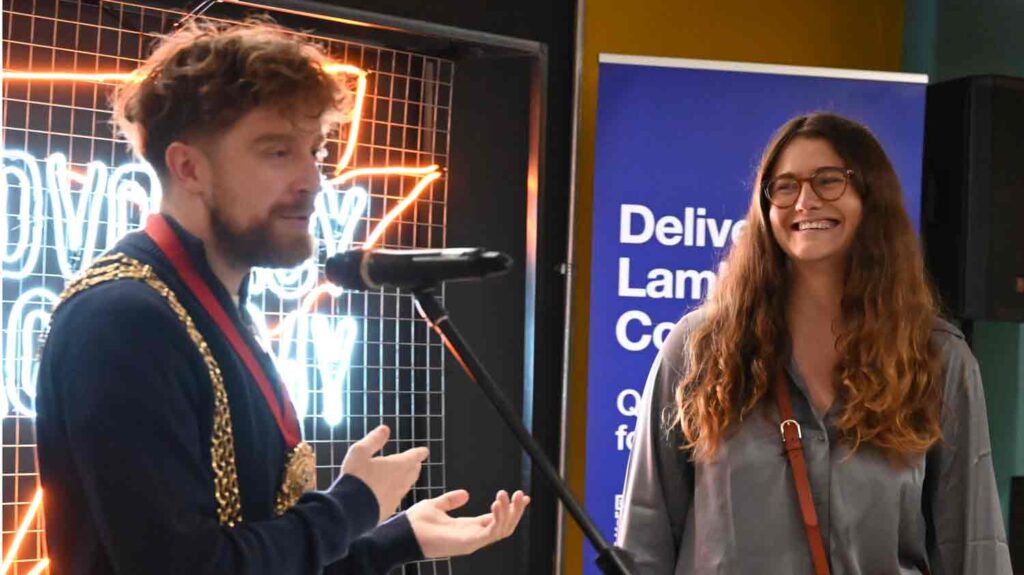
Two organisations that contribute to Brixton’s unique culture celebrated a new home in Brixton Rec yesterday (30 September).
A £4m project to revitalise the “Rec Quarter” has provided Photofusion and The Advocacy Academy with smart new premises, and new frontages and interior makeovers for longstanding local shops like Bambinos.
Half the money came from Lambeth council and half from the Mayor of London’s Good Growth Fund.
Both Photofusion and The Advocacy Academy bring major benefits to Brixton.
The first, established in 1990, offers training and other opportunities to local people as well as being an important photographic institution in its own right.
Advocacy Academy founded in 2014, is a unique venture. It has trained and enabled local young people to channel their idealism and anger into effective political action.

John Paul Ennis, mayor of Lambeth, and a Brixton councillor, is both a graduate of the Advocacy Academy and a Rec user.
“The Rec has been a special part of my life,” he told the opening ceremony audience, “I think it’s probably where I learned to swim. It’s where I play football sometimes, and – it doesn’t really look like it – but sometimes I go to the gym.”
He joined the Advocacy Academy “at a time when I was about to be kicked out of my house, kicked out of my school, and I had a lot of anger about systems and what was fair.
“The Advocacy Academy didn’t tell me to stop being angry. Instead, they gave me direction. So by teaching me about different issues and social justice and equipping me with the tools to tackle them, it allowed me to channel my anger into something more productive.
“That’s why I’m really, really pleased that this space will be able to provide the Advocacy Academy with the foundations to grow and support many more young people to become campaigners, organisers, and advocates in their own communities.”

Jules Pipe, deputy mayor of London for planning and regeneration, said the Rec is “an incredibly iconic building and absolutely at the heart of the community”.
It had played a huge role in community events and activities, and also community struggles. “It’s right at the heart of the UK’s Black struggle for rights”. Not for nothing had Nelson Mandela asked to visit it.
What the council had done with its renewal of the building – turning redundant storage space into a home for two vital projects was what the Mayor’s Good Growth Fund was all about, Jules Pipe said.

Lambeth council leader Claire Holland said hundreds of people would be given learning opportunities and supported into employment from the new space.
“But that’s only part of the story that we’re celebrating today,” she said. “We have new architectural lighting that celebrates the Rec’s landmark architecture, as well as making the street feel more welcoming and less dark.” Original signage, now back in place, had been saved and looked after by the Brixton Rec User Group, she noted.
There is also a Wall of Fame honouring sporting greats nurtured by Rec-based organisations like Afewee football and boxing, Brixton Top Cats and the Brixton Fencing Club.

“We know that delivering projects like this isn’t easy. It does take a partnership, and we really have had a partnership here. It’s involved hard work, perseverance, and compromise. And it’s still there’s still work to do. We know that,” said Claire Holland
She thanked “all the shop owners, the market traders, and community activists who have brought their energy and commitment to Brixton Station Road and the Rec every single day through the good times and some of the challenging times as well.”
She also thanked Photofusion and the Advocacy Academy for bringing their creative, inclusive, and social driven work to the new space, and the deputy mayor and the Mayor of London and the Greater London Authority for their contribution.
Introducing Steadman Scott, co-founder of Afewee (Patois for “It’s for us”) John Paul Ennis said every Premier League football club in London has hosted an Afewee boy or girl.

Steadman Scott warned that, over the years, he had seen the Brixton move from being a West Indian community to one where he felt a stranger.
The vision of George Finch, the Rec architect, and the visit of Nelson Mandela, meant that the community must be in the Rec “from top to bottom, black and white, rich and poor,” he said.
“If you work with the community, you can be successful. You cannot work on your own.”
If the council and others wanted to heal the Brixton community, said Steadman Scott, they had to make sure that organisations like Afewee had a safe future in the Rec and were not priced out.
Introducing photographer Josie Kyan, John Paul Ennis said Steadman Scott had underlined the importance of the Rec as somewhere that changed people’s lives “showing why, at a very fundamental level, investing in direct brick and mortar, as well as people, is so important”.

Josie Kyan told “the personal story of how Photofusion affected my life”.
She was working in the film industry, but never getting a chance to be creative. During Covid, she worked in refugee camps around Calais and, returning to England, worked for a refugee charity based in Brixton’s 3Space International House, at that time also the home of Photofusion.
She picked up one of their flyers and, on an adult learning course with Photofusion, she once again felt the excitement of being creative. And “people were taking my photography seriously and discussing it in a classroom as if it mattered. I was touched that my creativity was being valued again and to be around like-minded souls who felt the same way. I learned things that I didn’t even know I wanted to learn.”
“Without Photofusion,” Josie Kyan said, “I wouldn’t have had the skills or confidence to take the photos which are displayed here today, nor would I have had the friends that are truly going to be the long-term support needed to keep pursuing my creative career.
“With the support of people I’ve met on the course and the reigniting of my relationship with creativity, I’m continuing to pursue my creative passions.
“I’m working towards starting a film and photography production company that works with global majority and asylum-seeking voices to tell their stories and to help give them the skills to tell their own whilst also pursuing my own creative stories.”

Local MP Helen Hayes recalled that she too had done a Photofusion course when she moved to Brixton almost 30 years ago.
Speaking as a former town planner about the listing of the Rec by Historic England, she said there could be a caricature of “heritage” as being only about “really grand things, that are for somebody else”.
“But that’s completely wrong,” she said the MP. “Heritage and history is the history of what happens every single day in our communities, and this building is a real emblem of the history of community action and activism in Brixton.
“It is a history of opportunities that have been fought for because somebody noticed and spoke up about the fact that they weren’t there. It is a history of struggle against injustice, and it is a history of fighting to keep it as well.”

Closing the formal part of the ceremony, John Paul Ennis thanked Lambeth council principal neighbourhood regeneration officer Martha Levi Smythe who was involved in the project from the start. “She epitomises all that is good about the project,” he said.
Final additions to “Rec Quarter” will include semi-mature trees planted between market pitches on Brixton Station Road and restored and reinstated Rec signage on its Beehive Place frontage.

This model of the Rec, created in 2019, shows the approach taken to the renovation of the Rec by ‘small acts of repair’ and reflects its function as a ‘social condenser’ by representing a cross section of the long views through and up the building visually connecting its different spaces







